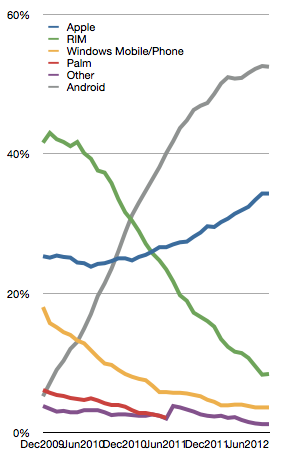Not sure if this has anything to do with smartphone penetration rate in the United States and in various other markets passing the 50 percent milestone, but a credible analysis shows that even though Android’s growth was unstoppable in the past twelve months, capturing a whopping 75 percent of all smartphones sold in the third quarter, Google’s platform is slowing over past six months while iOS is still making healthy gains.
Respectable independent analyst Horace Dediu took the latest comScore data to chart the two platform’s growth. He discovered a recent split of 23.5 million for Android and 17 million units for iOS as Google’s platform gained 58 percent of the growth and Apple captured 42 percent. That’s a notable change in spread in Apple’s favor versus the 24-month period when Android captured 70 percent of the growth and iOS captured 30 percent of the growth…
According to Dediu’s anaylsis, Android is slowing over past six months while iOS is still gaining. Explaining the late smartphone adopter paradox, the analyst wrote:
Therefore, paradoxically, the late market shows that the prospect for iOS growth seems strong. Furthermore, as we do reach saturation, perhaps in another three years, the secular growth may end in the US but the loyalty of iOS usage may give iOS another advantage in a market where growth is determined by platform churn.
The rate at which non-smart to smart conversion is happening is pretty steady, as seen in the top chart. Bear in mind it shows net new users and therefore excludes smartphone switchers, but it’s “a good measure of how rapidly non-consumers are being converted to consumers”.
No wonder there are now more than a billion smartphones in use.
Here’s the key chart indicating a slowdown in Android’s momentum and a steady growth for iOS.
The chart also makes me wonder what would have happened to Android if Samsung hadn’t been so successful on the platform.
Of course, Apple really cannot expect to compete with Android on unit sales simply because Google’s platform is found on the widest array of form factors, carriers and price points.
Together, however, the two platform’s hold the lion’s share of the smartphone market.
Just don’t read too much into the numbers thrown around these days because statistics is a double-edged sword and IDCs and Gartners of this world have too often got it wrong by guesstimating data.

